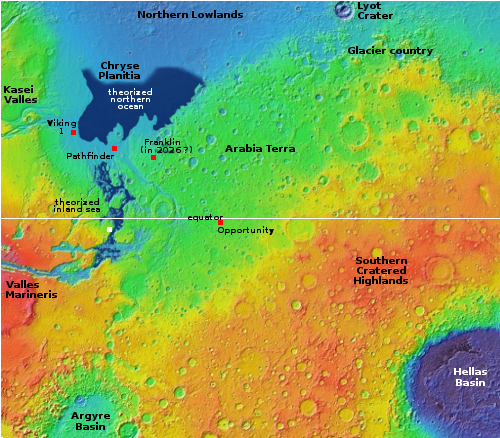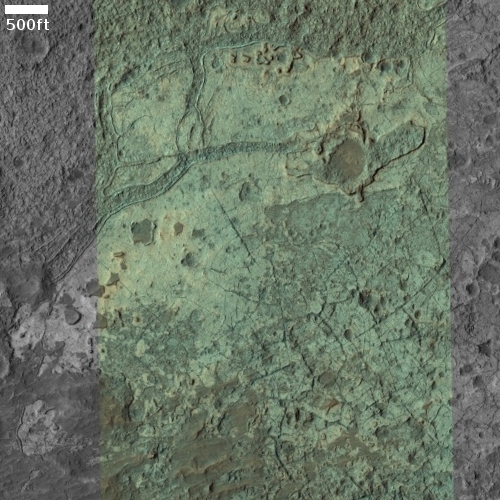Strange terrain at the Martian equator
Cool image time! The photo to the right, cropped to post here, was taken on January 29, 2022 by the high resolution camera of Mars Reconnaissance Orbiter (MRO). It shows a small portion of the floor of 41-mile-wide Tuskegee Crater, sitting at the Martian equator on the rim of the outlet to the giant canyon Valles Marineris.
I have purposely focused on a section of the color strip, because of its strange green color. Most MRO images are reddish (indicating dust) or blue (indicating coarse rocks or ice). Green seems to me to be rare, and in fact is not even mentioned in the MRO science’s team explanation [pdf] of the colors the instrument produces. Since green is neither dust nor ice, this suggests some form of hard bedrock, with a mineralogy that produces that color.
The overview map below gives some context.

The white dot just south of the equator marks the location of Tuskegee Crater. The full image above covers a small relatively flat section in the crater floor’s northwest quadrant between a small interior crater to the west and the crater’s central peak to the east.
At this latitude, 2.7 degrees south, scientists have so far found no evidence of underground ice. Thus, the surface features here, as suggested by the green color, are either bedrock or old impact melt. What shaped these features into these strange shapes however is beyond my pay grade to explain. A first wild guess would propose these are the remains of melted lava that froze soon after the initial impact or the impact of that nearby interior small crater. Having been preserved for eons by being buried, this impact lava has now been exposed and further eroded by wind.
On Christmas Eve 1968 three Americans became the first humans to visit another world. What they did to celebrate was unexpected and profound, and will be remembered throughout all human history. Genesis: the Story of Apollo 8, Robert Zimmerman's classic history of humanity's first journey to another world, tells that story, and it is now available as both an ebook and an audiobook, both with a foreword by Valerie Anders and a new introduction by Robert Zimmerman.
The print edition can be purchased at Amazon or from any other book seller. If you want an autographed copy the price is $60 for the hardback and $45 for the paperback, plus $8 shipping for each. Go here for purchasing details. The ebook is available everywhere for $5.99 (before discount) at amazon, or direct from my ebook publisher, ebookit. If you buy it from ebookit you don't support the big tech companies and the author gets a bigger cut much sooner.
The audiobook is also available at all these vendors, and is also free with a 30-day trial membership to Audible.
"Not simply about one mission, [Genesis] is also the history of America's quest for the moon... Zimmerman has done a masterful job of tying disparate events together into a solid account of one of America's greatest human triumphs."--San Antonio Express-News
Cool image time! The photo to the right, cropped to post here, was taken on January 29, 2022 by the high resolution camera of Mars Reconnaissance Orbiter (MRO). It shows a small portion of the floor of 41-mile-wide Tuskegee Crater, sitting at the Martian equator on the rim of the outlet to the giant canyon Valles Marineris.
I have purposely focused on a section of the color strip, because of its strange green color. Most MRO images are reddish (indicating dust) or blue (indicating coarse rocks or ice). Green seems to me to be rare, and in fact is not even mentioned in the MRO science’s team explanation [pdf] of the colors the instrument produces. Since green is neither dust nor ice, this suggests some form of hard bedrock, with a mineralogy that produces that color.
The overview map below gives some context.

The white dot just south of the equator marks the location of Tuskegee Crater. The full image above covers a small relatively flat section in the crater floor’s northwest quadrant between a small interior crater to the west and the crater’s central peak to the east.
At this latitude, 2.7 degrees south, scientists have so far found no evidence of underground ice. Thus, the surface features here, as suggested by the green color, are either bedrock or old impact melt. What shaped these features into these strange shapes however is beyond my pay grade to explain. A first wild guess would propose these are the remains of melted lava that froze soon after the initial impact or the impact of that nearby interior small crater. Having been preserved for eons by being buried, this impact lava has now been exposed and further eroded by wind.
On Christmas Eve 1968 three Americans became the first humans to visit another world. What they did to celebrate was unexpected and profound, and will be remembered throughout all human history. Genesis: the Story of Apollo 8, Robert Zimmerman's classic history of humanity's first journey to another world, tells that story, and it is now available as both an ebook and an audiobook, both with a foreword by Valerie Anders and a new introduction by Robert Zimmerman.
The print edition can be purchased at Amazon or from any other book seller. If you want an autographed copy the price is $60 for the hardback and $45 for the paperback, plus $8 shipping for each. Go here for purchasing details. The ebook is available everywhere for $5.99 (before discount) at amazon, or direct from my ebook publisher, ebookit. If you buy it from ebookit you don't support the big tech companies and the author gets a bigger cut much sooner.
The audiobook is also available at all these vendors, and is also free with a 30-day trial membership to Audible.
"Not simply about one mission, [Genesis] is also the history of America's quest for the moon... Zimmerman has done a masterful job of tying disparate events together into a solid account of one of America's greatest human triumphs."--San Antonio Express-News



Had a look at the enlarged color image. Obviously canals.
I found the upper section more interesting. There appears to be a crater along an escarpment. The ground immediately below the cliff is heavily cratered; the ground above, moderately so. The escarpment has almost no craters.
Perhaps you have commented on this feature?
Blair Ivey: I have not commented on the features near the top of the full image. Some thoughts however:
1. The escarpment is a ridge inside the crater. The north rim of Tuskegee Crater is beyond the top edge of this photo by a few miles. To get the context quickly, go to the image’s main page (the link under the image date) and zoom in on the context map near the bottom of the page. You will see what part of the crater floor the photo covers.
2. The small craters (which are actually both sides of the ridge) might be from impact, but I wonder if some are related to erosion of impact melt, leaving behind a pock-marked surface. Many of those depressions are from impact, likely secondaries from the small crater just to the west, its eastern rim just visible near the bottom left of the photo.
3. The lack of small craters on the ridge could be for many reasons. I would be merely guessing. Not enough information to guess intelligently.
Is there an associated CRISM scene? Some of the color HiRISE scenes over phyllosilicate bearing terrains can have a green color.
Bill Farrand: You should be more capable than I in answering this question. Also, can you give us more details on what phyllosilicate bearing terrains are?